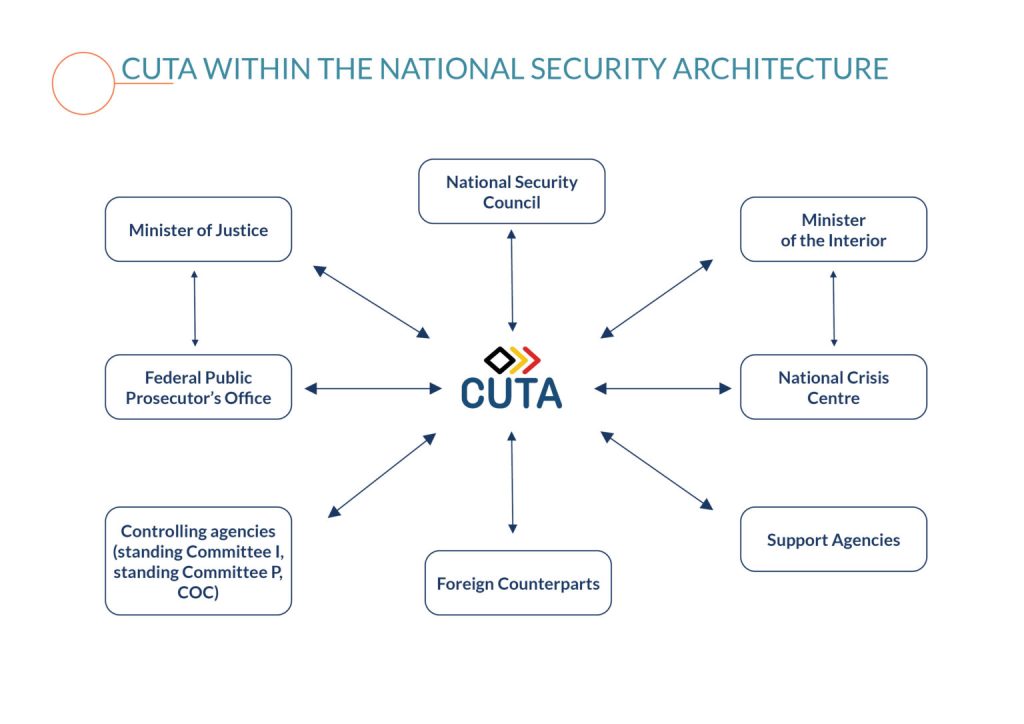Who we are

CUTA is the independent Belgian centre of knowledge and expertise in charge of assessing the terrorist and extremist threat in Belgium and against Belgian citizens and interests abroad. Furthermore, CUTA is charged with the coordination of this approach. The service is under the aegis of the Minister of Justice and the Minister of the Interior.
CUTA is completely independent in the fulfilment of its remits. This independence ensures neutral and objective threat assessments.
Since October 2020, Gert Vercauteren is in charge of CUTA as director ad interim.
“Terrorism does not occur in a vacuum. It is often preceded by a process of polarisation and radicalisation. Alienation from our society makes individuals vulnerable to influence by extremist ideologies. That’s why the fight against violent extremism and terrorism begins first and foremost with a commitment to and for an inclusive society. We must prevent that societal problems turn into security issues.
Since the terrorist crisis of 2016, the services have learned a lot, inter alia, to benchmark with peers and to work together. This cooperation has since been structurally anchored in various consultation platforms. This is organised both nationally, regionally and locally, both from a repressive and preventive approach, with adapted tools to process and share information.
Download here the document with our mission, vision and values.
History in brief
CUTA has grown considerably in recent years. Not only in terms of personnel, also our remits and fields of competence have been significantly expanded. In the early years, CUTA primarily drew up threat assessments and analyses. Nowadays it does a lot more. Amongst other, CUTA is the coordinator of the Strategic Note Extremism and Terrorism (Strategy T.E.R.) and the operational manager of the Common Database (CDB).
-
1984 - 1984 – Founding of the Mixed Anti-Terrorism Group
In the context of the terrorist threat, the Mixed Anti-Terrorism Group (Groupe Interforces antiterroristes in French) was set up in Belgium in 1984. At that time, the primary mission of the GIA was to collect and analyse intelligence in a coordinated way. This enabled the police services to take appropriate measures against terrorism in Belgium. The GIA was the first office for intelligence merging of its kind. The limited number of GIA partners and the fact they were not obliged to provide information, were obstacles to an efficient monitoring of the terrorist threat.
-
2006 - 2006 – Establishment of the Coordination Unit for Threat Assessment
The Coordination Unit for Threat Assessment (CUTA) took over from the Mixed Anti-Terrorism Group (GIA) in 2006. The basic remits of the GIA remained unchanged. CUTA draws up analyses and assessments based on the information and intelligence it receives from its partner services. An important difference with the GIA is that the partner services are now legally obliged to provide all relevant information and intelligence to CUTA.
Our partners
CUTA is under the aegis of the Ministers of Justice and the Interior and reports to the government through the National Security Council. The bodies supervising CUTA are the Standing Committee P (Supervisory Body of the Police Services), the Standing Committee I (Supervisory Body for the Intelligence Services) and the COC (Supervisory Body for Police Information). In addition, CUTA works closely with the National Crisis Centre, the Public Prosecutor’s Office and, of course, all its partners.
The last element in the chain is the contacts with partners abroad, with whom a smooth flow of information is also important.

Our support services determined by law
- Integrated Police services
- Belgian State Security (VSSE)
- Military Intelligence Service (SGRS)
- FPS Mobility & Transport
- FPS Interior
- Immigration Office
- National Crisis Centre
- FPS Foreign Affairs
- FPS Finance
- Customs & Excise
- Treasury
- FPS Justice
- Department of Religions and Humanism
- Directorate General for Prison Facilities
Our other partner services
- Belgian Financial Intelligence Processing Unit (CTIF-CFI)
- Federal Public Prosecutor’s Office
- Centre for Cybersecurity Belgium (CCB)
- Regions & Communities
- Local Partners
- municipalities, prevention & deradicalisation officers
Legal framework
Legal framework and legislation
- Act of 10 July 2006 on the Threat Analysis (organic law)
- Royal Decree of 28 November 2006 (remits/organisation)
- Royal Decree of 23 January 2007 (staff)
- Royal Decree of 24 August 2007 (staff function allowance)
- Royal Decree of 17 August 2018 (4 new support services)
Individual preventive administrative measures (freezing of assets, Pass-Ban, ID-Ban):
- Act of 25 April 2007 (art. 115 – freezing of assets) ratifying the Royal Decree of 28 December 2006 with regard to specific restrictive measures against certain individuals and entities in the fight against the financing of terrorism
- The Consular Code (Art. 39/1 and following for the ID-ban, art. 62 and following for the Pass-ban)
- Act of 19 July 1991 on the population registers, identity cards, foreigner identity cards and residence permits
Common Database
- Act of 5 August 1992 on the Police Service
- Royal Decree of 21 July 2016 on the common database of Foreign Terrorist Fighters
- Royal Decree of 23 April 2018 on the common database of Hate Propagandists and implementing certain provisions of Section 1bis ‘Information Management’ of Chapter IV of the Law on the Police Service
Strat T.E.R. and LISC
- Plan R approved by the National Security Council on 14 December 2015
- Act of 30 July 2018 regarding the creation of local integral security cells concerning radicalism, extremism and terrorism
- The Strategy T.E.R. approved by the consultation committee on 8 September 2021
Other
- Act of 30 November 1998 governing the intelligence and security services
- Act of 1 July 2011 (critical infrastructure)
- Royal Decree of 23 August 2014 organising the “Belgian Task Force for International Criminal Justice (BTF ICJ)”.
Terrorism
- 8 June 1867. – CRIMINAL CODE – TITLE Iter. – TERRORIST CRIMES.
- Royal Decree of February 2017 laying down the procedure according to which the King may proceed to acknowledge an act of terrorism within the meaning of Article 42bis of the Act of 1 August 1985
- International Convention of 14 September 2005 for the Suppression of Acts of Nuclear Terrorism
- Act of 18 May 2020 establishing the national emergency plan for dealing with a terrorist hostage-taking or terrorist attack
Control bodies
- Act of 18 July 1991 regulating the supervision of police and intelligence services and of the Coordination Unit for Threat Analysis
- Act of 11 December 1998 on classification and security clearances, security certificates and security advice
- Royal Decree of 22 December 2020 on the setting up the National Security Council, the Strategic Intelligence and Security Committee and the Intelligence and Security Coordination Committee

